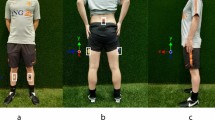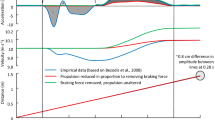Abstract
Previous experiments by our group in normal gravity (1 G) have revealed spatial relationships between postural and focal components of whole-body reaching and pointing movements. We suggested that these relationships could be explained partly through the use of gravity to displace the CoM and attain the object or target position. In this study we compared human whole-body reaching in 1 G and microgravity (0 G) in order to more fully investigate how gravity contributes to strategies adopted for task execution and to determine possible invariant temporal relationships between multiple segments. Whole-body reaching movements made from the standing position in two experimental conditions of execution speed (naturally paced and as fast as possible) were recorded during periods of 1 G and 0 G in parabolic flight. Overall, at each speed of reaching, movement times were significantly slower when performed in 0 G than in 1 G for two of the three subjects, but all subjects were able to produce significantly faster movements in 0 G than in 1 G. Despite similar general trends across subjects observed in 1 G, angular displacements of reaching movements performed in 0 G differed greatly between subjects. There were changes at all joints, but above all at the shoulder and the ankle. However, despite a high intersubject and intratrial variability in 0 G, in both gravity conditions all subjects demonstrated times to peak curvilinear velocity for the finger (end effector) and the whole-body centre of mass (CoM) that coincided, regardless of the speed of execution. Moreover, cross-correlations between multiple segment curvilinear velocities and those of the CoM revealed tight, highly correlated temporal relationships between segments proximal to the CoM (which was expected). However, for more distal segments, the correlations were weaker, and the movements lagged behind movements of the CoM. The major and most interesting finding of this study was that although the finger was the most distal within the segment chain, with respect to the CoM, it was highly correlated with the CoM (0.99–0.98, all conditions) and with no time lag. Despite the large intersubject and interenvironmental variability recorded in this study, temporal relationships between postural task components (CoM displacements) and those of the focal movement (end-effector trajectory) were consistently conserved.




Similar content being viewed by others
References
Alexandrov A, Frolov A, Massion J (1998) Axial synergies during human upper trunk bending. Exp Brain Res 118:210–220
Amblard B, Assaiante C, Lekhel H, Marchand AR (1994) A statistical approach to sensorimotor strategies: conjugate cross-correlations. J Motor Behav 26:103–112
Amblard B, Assaiante C, Fabre JC, Mouchnino L, Massion J (1997) Voluntary head stabilization in space during oscillatory trunk movements in the frontal plane performed in weightlessness. Exp Brain Res 114:214–225
Bock O, Howard IP, Money KE, Arnold KE (1992) Accuracy of aimed arm movements in changed gravity. Aviat Space Environ Med 63:994–998
Cheron G, Bengoetxea A, Bouillot E, Lacquaniti F, Dan B (2001) Early emergence of temporal co-ordination of lower-limb segments elevation angles in human locomotion. Neurosci Lett 308:123–127
Crenna P, Frigo C, Massion J, Pedotti A (1987) Forward and backward axial synergies in man. Exp Brain Res 65:538–548
Ferrigno G, Baroni G, Pedotti A (1999) Methodological and technological implication of quantitative human motion analysis in long-term space flight. J Biomech 32:431–436
Flanagan JR, Wing AM (1997) The role of internal models in motion planning and control: evidence from grip force adjustments during movements of hand-held loads. J Neurosci 17:1519–1528
Hasan Z, Thomas JS (1999) Kinematic redundancy. Prog Brain Res 123:379–387
Kaminski TR, Bock C, Gentile AM (1995) The coordination between trunk and arm motion during pointing movements. Exp Brain Res 106:457–466
Kawato M (1999) Internal models for motor control and trajectory planning. Curr Opin Neurobiol 9:718–727
Kerlirzin Y, Pozzo T, Dietrich G, Vielledent S (1999) Effects of kinematic constraints on hand trajectory during whole-body lifting tasks. Neurosci Lett 277:41–44
Kingma I, Toussaint HM, Commissaris DACM, Savelsbergh GJP (1999) Adaptation of center of mass control under microgravity in a whole-body lifting task. Exp Brain Res 125:35–42
Kruskal W, Wallis WA (1952) The use of ranks in one-criterion analysis of variance. J Am Statist Assoc 52:583–621
Lackner JR, DiZio P (2000) Human orientation and movement control in weightless and artificial gravity environments. Exp Brain Res 130:2–26
Lepers R, Breniere Y (1995) The role of anticipatory postural adjustments and gravity in gait initiation. Exp Brain Res 107:118–124
Looze de MP, Kingma I, Bussman JBJ, Toussaint HM (1992) Validation of a dynamic linked segment model to calculate joint moments in lifting. Clin Biomech 7:161–169
Ma S, Feldman AG (1995) Two functionally different synergies during arm reaching movements involving the trunk. J Neurophysiol 73:2120–2122
Massion J (1992) Movement, posture and equilibrium: interaction and coordination. Prog Neurobiol 38:35–56
Massion J, Popov K, Fabre JC, Rage JC, Gurfinkel V (1997) Is the erect posture in microgravity based on the control of trunk orientation or center of mass position? Exp Brain Res 114:384–389
Patron J, Stapley PJ, Pozzo T (2004) Microgravity reveals invariant temporal relationships between focal and equilibrium components of whole body reaching. Presented at the 25th International Gravitational Physiology Meeting, Moscow, Russia, 6–11 June 2004
Pedrocchi A, Baroni G, Massion J, Pedotti A, Ferrigno G (2003) Inverse dynamic investigation for voluntary trunk movements in weightlessness: a new microgravity-specific strategy. J Biomech 36:1691–1700
Plagenhoef S, Gaynor-Evans FG, Abdelnour T (1983) Anatomical data for analyzing human motion. Res Q Exerc Sport 54:169–178
Pozzo T, Berthoz A, Popov K (1995a) Effects of weightlessness on posture and movement control during a whole body reaching task. Acta Astronautica 36:727–732
Pozzo T, Levik Y, Berthoz A (1995b) Head and trunk movements in the frontal plane during complex dynamic equilibrium tasks in humans. Exp Brain Res 106:327–338
Pozzo T, McIntyre J, Cheron G, Papaxanthis C (1998) Hand trajectory formation during whole body reaching movements in man. Neurosci Lett 240:159–162
Pozzo T, Stapley PJ, Papaxanthis C (2002) Coordination between equilibrium and hand trajectories during whole body pointing movements. Exp Brain Res 144:343–350
Schepens B, Drew T (2003) Strategies of the integration of posture and movement during reaching in the cat. J Neurophysiol 90:3066–3086
Semjen A, Leone G, Lipshits MI (1998) Temporal control and motor control: two functional modules which may be influenced differently under microgravity. Hum Mov Sci 17:77–93
Sergio LE, Ostry DJ (1994) Coordination of mono-and bi-articular muscles in multi-degree of freedom elbow movements. Exp Brain Res 97:551–555
Stapley P, Pozzo T, Grishin A (1998) The role of anticipatory postural adjustments during forward whole body reaching movements. Neuroreport 9:395–401
Stapley PJ, Pozzo T, Cheron G, Grishin A (1999) Does the coordination between posture and movement during human whole-body reaching ensure center of mass stabilization? Exp Brain Res 129:134–146
Stapley P, Pozzo T, Grishin A, Papaxanthis C (2000) Investigating centre of mass stabilisation as the goal of posture and movement coordination during human whole body reaching. Biol Cybern 82:161–172
Tyler AE, Hasan Z (1995) Qualitative discrepancies between trunk muscle activity and dynamic postural requirements at the initiation of reaching movements performed while sitting. Exp Brain Res 107:87–95
Vernazza-Martin S, Martin N, Massion J (2000) Kinematic synergy adaptation to microgravity during forward trunk movement. J Neurophysiol 83:453–464
Wolpert DM, Kawato M (1998) Multiple paired forward and inverse models for motor control. Neural Netw 11:1317–1329
Zar JH (1999) Biostatistical analysis, 4th edn. Prentice Hall, Englewood Cliffs NJ
Acknowledgements
This work was supported both logistically and financially by the Centre National d’Etudes Spatiales (CNES). P.S. was supported during this work by a research grant from the Institut Garches, Paris, France, and a Marie Curie Individual Fellowship (QLK6-CT-2001-51883). We would like to thank Drs. Julie Côté and Allan Smith as well as the two anonymous reviewers for their very helpful comments on an earlier version of the manuscript.
Author information
Authors and Affiliations
Corresponding author
Appendix
Appendix
Figure 5
Curvilinear velocity profiles of the whole body CoM calculated using six-segment and seven-segment models for both naturally paced and fast movements for one typical subject (taken from the database of Stapley et al. 1999). It can clearly be seen that the velocity profiles resulting from the two different calculations show a high degree of similarity.
Rights and permissions
About this article
Cite this article
Patron, J., Stapley, P. & Pozzo, T. Human whole-body reaching in normal gravity and microgravity reveals a strong temporal coordination between postural and focal task components. Exp Brain Res 165, 84–96 (2005). https://doi.org/10.1007/s00221-005-2283-0
Received:
Accepted:
Published:
Issue Date:
DOI: https://doi.org/10.1007/s00221-005-2283-0





